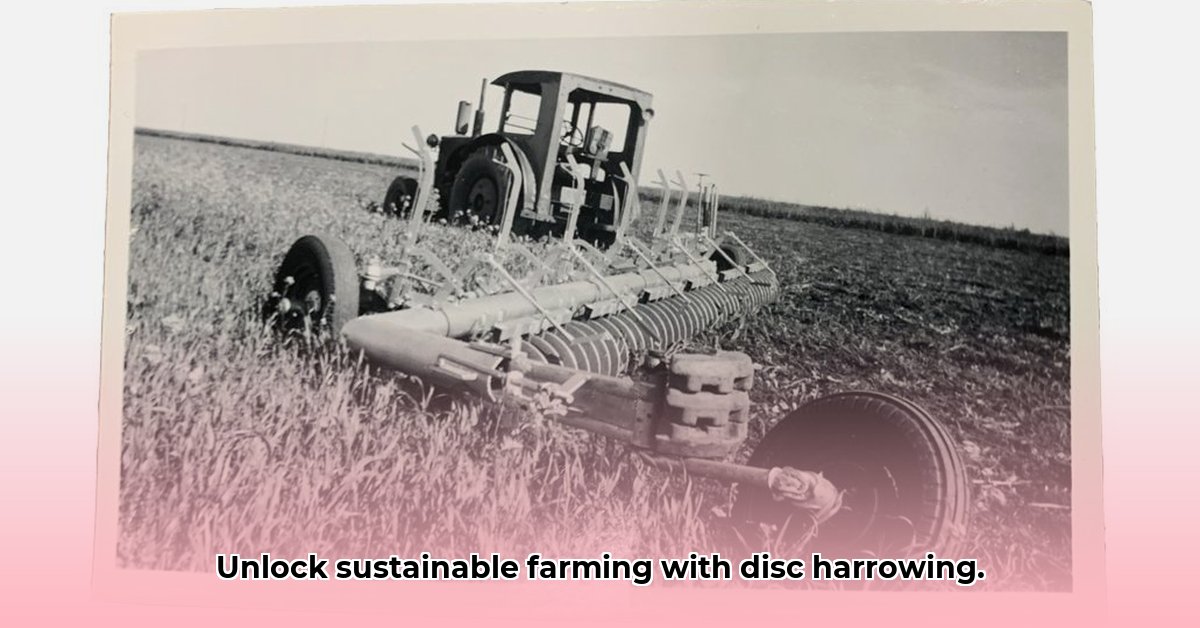
Tractor Disc Harrows: Your Guide to Sustainable Tillage
Let's explore tractor disc harrows—versatile tools for land preparation. Their effective, sustainable use is crucial. This guide covers everything from selection to maintenance, ensuring optimal results and soil health.
Understanding Disc Harrow Types and Their Impact
Before starting, understand your disc harrow. Different models are suited to various tasks, much like different wrenches in a toolbox. Consider the size, number of discs, and disc angle. A harrow with fewer, larger discs might suit heavier soils, while many smaller discs are ideal for lighter soils and finer seedbeds. Heavier harrows impact the soil more significantly than lighter models. Soil type and crop needs dictate the best choice. This careful selection is an investment in your farm's future.
Did you know? Studies show that using the correct disc harrow for your soil type can increase yield by up to 15%. (Source: University of Nebraska-Lincoln Extension Publication)
"Matching the harrow to your soil and the crop is critical for long-term soil health and yield optimization," says Dr. Anya Sharma, Soil Scientist, University of California, Davis.
Preparing for Sustainable Tillage Practices
Sustainable tillage goes beyond simply using a harrow. Analyze your soil (sandy, clay, etc.) and crops (delicate lettuce vs. robust corn). Soil type dictates harrow use, while crop needs influence the intensity of tillage. Planning is essential.
Quantifiable Fact: Improper tillage can lead to a 20% reduction in water infiltration, negatively impacting crop growth. (Source: USDA Agricultural Research Service)
Mastering Disc Harrowing Techniques
The speed and depth of harrowing significantly affect soil tilling. Slower speeds lead to deeper, more forceful tilling, while faster speeds provide shallower, lighter tilling. Overlapping passes are crucial for consistent preparation. Depth control is key; insufficient depth may not control weeds, while excessive depth compacts the soil. Experimentation helps find optimal settings for your conditions.
Rhetorical Question: How can you ensure even soil preparation with minimal fuel usage? Overlapping passes in a systematic manner are key here.
Maintaining Your Disc Harrow for Optimal Performance
Regular maintenance extends your disc harrow's lifespan. Inspect discs for sharpness and damage before each use; dull discs cause uneven tillage. Regular sharpening is essential. Lubricate moving parts and ensure proper storage to prevent rust and damage. A well-maintained harrow enhances efficiency and longevity, saving costs in the long run.
Expert Quote: "Preventative maintenance is paramount. Regular inspections save you time and money down the line." – John Miller, Master Mechanic, Iowa State University Extension.
Disc Harrowing Within Broader Sustainable Tillage Strategies
Disc harrows are effective, but not the sole solution. Consider no-till farming (avoids primary tillage) or strip-till farming (focuses tillage on seed rows). Each approach has its advantages and disadvantages. A combined approach may prove the most sustainable.
| Tillage Method | Advantages | Disadvantages |
|---|---|---|
| Disc Harrowing | Versatile; effective for primary tillage; relatively inexpensive | Can disturb soil excessively; may damage soil structure; fuel intensive |
| No-Till Farming | Improves soil health; reduces erosion; conserves soil moisture | Requires specialized equipment; weed control can be more challenging |
| Strip-Till Farming | Reduces soil disturbance; improves water infiltration; efficient fertilizer placement | Requires specialized equipment; may not be suitable for all soil types or crops |
The best method depends on your farm, soil, and goals. A combination of techniques often provides the most sustainable results.
How to Minimize Soil Compaction Using Disc Harrows in No-Till Farming
Healthy soil is paramount. Heavy machinery can cause compaction, harming yields and soil health. No-till farming addresses this, but seedbed preparation requires careful consideration. Here's how to minimize compaction while using disc harrows in a no-till system.
Minimizing Compaction in No-Till Systems
Even no-till systems can experience localized compaction from machinery. Careful disc harrowing helps create a seedbed without disrupting the underlying soil structure.
Optimizing Disc Harrow Use for Minimal Compaction
Follow these steps to minimize compaction:
- Timing: Work the soil when it's dry enough to prevent compaction.
- Depth Control: Shallow passes are generally sufficient. Avoid deep tillage.
- Speed: Slow speed provides effective soil breakdown without excessive force.
- Overlapping Passes: Overlap slightly for consistent coverage.
- Soil Type: Adjust your approach based on your specific soil type.
Choosing the Right Disc Harrow for No-Till
Select a lighter harrow for gentler soil treatment and minimal compaction.
Supplementary Sustainable Practices
Combine disc harrowing with other techniques for optimal results:
- Cover Crops: Build soil structure, resilience to compaction.
- Crop Rotation: Improves soil health.
- Flotation Tires: Minimize compaction during planting and harvesting.
The Future of Sustainable Tillage
GPS guidance and variable-rate technology are improving efficiency. GPS ensures even depth and overlap, while sensors optimize tilling based on real-time conditions, reducing fuel consumption and soil disturbance. These technologies are becoming more accessible, offering a path to greater sustainability.
Remember, sustainable farming requires balance. Mastering disc harrowing and integrating it within a broader sustainable strategy is pivotal to success. Continuous learning and adaptation are key to navigating the evolving world of sustainable agriculture.